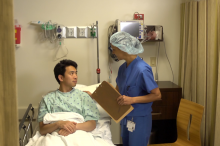At the Orbital Surgery Center of Excellence, the loss of an eye can be an extremely emotional event. Our surgeons are highly trained in the orbital area, including removal of the eye. Removing an eye is always an option reserved for severe cases, where all other options have been exhausted. Many times, removal of the eye is to control pain in a blind eye, improve the aesthetic appearance of a disfigured eye, or can follow a severe injury.
About Enucleation
Every eye is different, calling for a different treatment plan, team of surgeons, and objective. It is important to remember in cases in which removing the eye is an option, seeing a qualified surgeon is mandatory.
One of the eye removal surgery procedures performed at our outpatient surgery center is is called enucleation. Enucleation is the surgical removal of the entire eye. If the eye is affected by a tumor inside of the eye, enucleation is used to treat the tumor. In some cases following orbital trauma, if there is a risk of developing sympathetic ophthalmia your surgeon will also recommend you remove the entire eye. Ophthalmia is severe autoimmune condition.
Enucleation Surgery
At the Orbital Surgery Center of Excellence, enucleation is usually performed in the operating room under general anesthesia, although it can be completed safely using local anesthesia with sedation. Some patients stay the night at the surgery center while some can go home the same day. Please arrange for a ride to and from the surgery center before your surgery and a family member or friend to stay with you the first night at home after surgery.
An implant is usually made of polyethylene, alumina, or silicone rubber into a sphere shape and then placed into the eye. The patient’s own tissue covers the eye and in most cases, eye muscles are attached to the implant to allow natural eye movement. This implant will help to restore much of the natural volume lost during eye removal surgery.
About Prosthetics or Artificial Eyes
After surgery when your eye has healed, an artificial eye is made. A prosthesis, or artificial eye, is custom made and painted to match the patient’s other eye. The back of the prosthesis is also made to exactly fit the eye. This allows maximum comfort and movement. A prosthesis can last many years for a patient, sometimes decades and is easily removable for cleaning. Sometimes a peg can be inserted into the implant, to fix to prosthesis for better movement. This is not with all artificial eyes, only when offered by some surgeons.
After Enucleation Surgery
After your enucleation surgery, you will be given post-operative instructions to follow. These instructions help to allow you to heal without complications and should not be taken lightly. You should fill any prescriptions your doctor recommends such as pain medication, antibiotic, or steroids. Sometimes, you may have to wear a patch for several weeks until your next surgery as well. It is important to follow up with your doctor since during the healing process your eye tissue may change shape. Your surgeon can make sure the socket is healthy during your follow up appointments.
Best Eye Surgeons in Los Angeles at the Orbital Surgery Center of Excellence
Patients are most commonly treated by ophthalmic plastic and reconstructive surgeons who specialize in diseases and problems of the eyelids, tear drain, and orbit (the area around the eye).
You should look for a doctor who has completed an American Society of Ophthalmic Plastic and Reconstructive Surgery (ASOPRS) fellowship. This indicates your surgeon is not only a board certified ophthalmologist, but also has had extensive training in ophthalmic plastic surgery.
To make an appointment or schedule a consultation with one of our surgeons, please contact the Orbital Surgery Center of Excellence or make your appointment online.
Next, learn about evisceration surgery.














